The Utilization of Shape Memory Alloy as a Reinforcing Material in Building Structures: A Review
Abstract
:1. Introduction
2. SMA Characteristics and Types
2.1. SMA Characteristics
2.1.1. SMA Phase Transition
2.1.2. SME
2.1.3. SE
2.1.4. High Damping
2.2. Types of SMA
3. The Application of SMA in Structural Components of Building
3.1. SMA-Reinforced Concrete Beams
3.1.1. Self-Healing Performance
3.1.2. Flexural Performance
3.1.3. Shear Performance
3.2. SMA-Reinforced Concrete Columns
3.2.1. Axial Compression Performance
3.2.2. Seismic Performance
3.3. SMA-Reinforced Beam–Column Joints
3.4. SMA-Reinforced Shear Walls and Concrete Slabs
4. SMA Isolation Devices in Building Structures
4.1. SMA Bearings
4.2. SMA Dampers
5. Practical Engineering Applications of SMA
6. Conclusions and Future Works
- (1)
- With its unique SME and SE characteristics, SMA can achieve deformation self-recovery. Different types of SMA have different recovery performance, among which NiTi-based SMA has strong comprehensive performance and a wide range of applications. It is the most common material in building structure research, but its price is relatively high.
- (2)
- The effect of SMA on enhancing the mechanical properties of structural components of buildings is affected by various factors, including the diameter and reinforcement ratio of SMA prestress value, tension method, and excitation method. With different loading modes, SMA enhances the self-healing, flexural, and shear properties of beam components, as well as the deformation energy dissipation capacity of column components, beam–column joints, and shear walls.
- (3)
- Because of its excellent SME and SE characteristics, SMA is used in bearings and dampers in building structures to improve their mechanical properties under earthquake conditions.
- (1)
- The construction technology standards regarding heating in SMA activation are not yet clear. Although excessive heat can be applied to ensure sufficient activation, in concrete components, excessive heat can hinder the formation of ettringite in the concrete matrix and cause longitudinal splitting cracks. The standardized SMA heating method needs to be improved.
- (2)
- In order to overcome the shortcomings of brittleness and easy cracking of traditional concrete, a strong combination of SMA and ECC or UHPC should be established to study the deformation self-recovery ability of SMA-ECC/SMA-UHPC composite material components.
- (3)
- SMA is relatively expensive. Considering the actual situation of the building structure, it is necessary to effectively combine SMA with other composite materials (such as CERP) to achieve their complementary advantages and enhance the performance and function of shape memory composite materials.
- (4)
- The influence of factors such as prestressed tension and anchorage, the splicing mode, and the SME driving mode of SMA on the deformation recovery performance of SMA-reinforced structural components should be considered.
- (5)
- Existing studies generally use wires with a small cross-sectional area as reinforcement materials. Few studies have been conducted using large-cross-section materials, and the relevant mechanical tests are limited to scale model components. In addition, the effects of state parameters such as temperature, pretension strain, and loading frequency on the SME of SMA still lack sufficient and effective data support. The nonlinear constitutive relationship of SMA in a complex stress state or multi-directional constraint state is still to be established.
Author Contributions
Funding
Institutional Review Board Statement
Informed Consent Statement
Data Availability Statement
Conflicts of Interest
Appendix A
| Function | Study Year | Installation Technique | Property | Type of Loading | Research Method |
|---|---|---|---|---|---|
| Self-healing | Sakai et al. [61]-2003 | Internal SMA reinforcement | SE | Three-point cyclic bending | Experimental |
| Li et al. [64,65]-2007 | Embedded Ni-Ti wires + CFRP plate | SME | Not reported | Experimental + Numerical | |
| Kuang and Ou [66]-2008 | Internal Ni-Ti SMA wires + adhesives | SE | Three-point cyclic bending | Experimental | |
| Xue et al. [68]-2009 | External installation of Ni-Ti SMA bars | SME | Four-point bending | Experimental | |
| Yang et al. [69]-2011 | Internal/External installation of Ni-Ti SMA bars | SME | Three-point bending | Experimental | |
| Sun et al.-2011[70]; 2013 [71] | Internal/External installation of Ni-Ti SMA bars | SME | Three-point bending | Experimental | |
| Choi et al. [63]-2015 | Internal Ni-Ti SMA fibers | SME | Three-point bending | Experimental | |
| Lee et al. [62]-2018 | Internal Ni-Ti/Ni-Ti-Nb SMA fibers | SME | Three-point bending | Experimental | |
| Bonilla et al. [67]-2018 | Internal Ni-Ti SMA wires + microcapsules | SME | Three-point bending | Experimental | |
| Flexural behavior | Abdulridha et al. [81]-2013 | Ni-Ti rebars as top and bottom longitudinal reinforcement at mid-span | SE | Four-point cyclic andreversed bending | Numerical |
| Shahverdi et al. [72]-2016 | Fe-SMA strips as NSM reinforcement | SME | Four-point bending | Experimental | |
| Shahverdi et al. [77]-2016 | Fe-SMA rebars embedded in a shotcrete layer | SME | Four-point bending | Experimental | |
| Hong et al. [73]-2018 | NSM Fe-SMA Strips | SME | Four-point bending | Experimental | |
| Rojob and El-Hacha [75]-2018 | NSM Fe-SMA rebars | SME | Freeze–thaw cycles and sustained load | Experimental | |
| Rojob and El-Hacha [76]-2018 | NSM Fe-SMA rebars | SME | Cycles of fatigue loading | Experimental | |
| Michels et al. [79]-2018 | Externally anchored Fe-SMA strips | SME | Four-point bending | Experimental | |
| Strieder et al. [80]-2018 | Externally anchored Fe-SMA strips | SME | Four-point bending | Experimental + Numerical | |
| Dolatabadi et al. [78]-2020 | Fe-SMA rebars embedded in a shotcrete layer | SME | Four-point bending | Numerical | |
| Yeon et al. [74]-2021 | Fe-SMA strips as NSM reinforcement | SME | Four-point bending | Numerical | |
| Hong et al. [82]-2022 | Fe-SMA rebars as bottom longitudinal reinforcement | SME | Four-point bending | Experimental | |
| Yeon et al. [141]-2022 | Fe-SMA rebars as tensile longitudinal reinforcement | SME | Four-point bending | Experimental | |
| Shear behavior | Mas et al. [88]-2016 | Externally installed Ni-Ti rectangular spirals | SE | Three-point cyclic bending | Experimental |
| Montoya-Coronado et al. [83]-2019 | Externally installed Fe-SMA strips as spirals | SME | Three-point bending | Experimental | |
| Cladera et al. [84]-2020 | Externally installed Fe-SMA strips as spirals | SME | Three-point bending | Experimental | |
| Ruiz-Pinilla et al. [86]-2020 | Externally installed Fe-SMA strips as spirals | SME | Three-point bending | Numerical + Analytical | |
| Czaderski et al. [87]-2020 | U-shaped ribbed bars + cement-based mortar | SME | Four-point bending | Experimental | |
| Ji et al. [89]-2022 | Internal Fe-SMA stirrups | SME | Four-point bending | Experimental + Numerical | |
| Abdulkareem et al. [85]-2023 | Externally installed U-shaped Fe-SMA strips as spirals | SME | Four-point bending | Experimental | |
| Hong et al. [90]-2023 | Internal Fe-SMA stirrups | SME | Four-point bending | Experimental + Numerical |
| Function | Study Year | Installation Technique | Property | Type of Loading | Research Method |
|---|---|---|---|---|---|
| Axial compression property | Shin and Andrawes [92,93]-2010 | External NiTiNb SMA spirals | SME | Uniaxial compression test | Experimental |
| Choi et al.-2010 [94,95], 2011 [96] | External NiTiNb/NiTi SMA wires/steel jackets | SME | Uniaxial compression test | Experimental | |
| Chen et al. [100]-2014 | External SMA wires + steel tubes | SME | Monotonic and cyclic loading | Numerical + Experimental | |
| Tran et al. [97]-2015 | External NiTi SMA wires | SME | Uniaxial compression test | Experimental | |
| Chen and Andrawes [103]-2017 | External NiTiNb SMA spirals | SME | Uniaxial cyclic loading | Experimental + Analytical | |
| Chen and Andrawes [104]-2017 | External NiTiNb SMA spirals | SME | Monotonic and cyclic loading | Analytical + Numerical | |
| Gholampour and Ozbakkaloglu [108]-2018 | External Ni-Ti SMA spirals | SME | Uniaxial compressive test | Experimental | |
| Hong et al. [99]-2020 | External NiTi SMA wires | SE | Uniaxial compressive test | Experimental + Analytical | |
| Suhail et al. [101]-2020 | External NiTiNb SMA spirals and FRP systems | SME | Uniaxial compressive test | Experimental | |
| El-Hacha and Abdelrahman [102]-2020 | External Ni-Ti SMA spirals | SME | Uniaxial compressive test | Experimental | |
| Khaled and El-Hacha [105]-2020 | External SMA spirals | SME | Uniaxial compressive test | Analytical | |
| Jeong et al. [106]-2022 | External Fe-SMA strips | SME | Uniaxial compressive test | Experimental | |
| Zerbe et al. [108]-2022 | External Fe-SMA strips | SME | Uniaxial compressive test | Experimental + Analytical | |
| Vieira et al. [109]-2022 | External Fe-SMA strips | SME | Uniaxial compressive test | Analytical + Numerical | |
| Han et al. [107]-2023 | External Fe-SMA strips + FRP | SME | Uniaxial compressive test | Experimental + Analytical | |
| Seismic performance | Shin and Andrawes [112]-2011 | External SMA spirals and FRP wraps | SME | Quasi-static lateral cyclic loading | Experimental |
| Shin and Andrawes [113]-2011 | External SMA spirals | SME | Quasi-static lateral cyclic loading | Experimental |
| Function | Study Year | Installation Technique | Property | Type of Loading | Research Method |
|---|---|---|---|---|---|
| Seismic performance | Youssef et al. [114]-2008 | Ni-Ti SMA internal reinforcement in the plastic hinge region | SE | Quasi-static reversed cyclic loading | Experimental |
| Alam et al. [115]-2008 | Ni-Ti SMA internal reinforcement in the plastic hinge region | SE | Quasi-static reversed cyclic loading | Analytical + Numerical | |
| Alam et al. [116]-2009 | Ni-Ti SMA internal reinforcement in the plastic hinge region | SE | Quasi-static reversed cyclic loading | Experimental + Numerical | |
| Zafar and Andrawes [121]-2015 | SMA internal reinforcement in the plastic hinge region + FRP | SE | Quasi-static reversed cyclic loading | Numerical + Analytical | |
| Oudah and El-Hacha [118]-2017 | Ni-Ti SMA internal reinforcement anchored using screw lock steel anchors | SE | Quasi-static cyclic loading | Experimental + Analytical | |
| Oudah and El-Hacha [119]-2018 | Ni-Ti SMA internal reinforcement in the plastic hinge region | SE | Quasi-static reversed cyclic loading | Experimental | |
| Nahar et al. [117]-2019 | Ni-Ti SMA internal reinforcement in the plastic hinge region | SE | Quasi-static reversed cyclic loading | Numerical + Analytical | |
| Navarro-Gómez and Bonet [122]-2019 | SMA bars and ultra-high-performance concrete in the plastic hinge region | SE | Quasi-static cyclic loading | Numerical | |
| Pei et al. [120]-2022 | SMA bars and a steel plate in the core area of the joint | SE | Low cyclic loading test | Experimental + Numerical | |
| Qian et al. [123]-2022 | ECC and SMA bars in the plastic hinge region | SE | Quasi-static cyclic loading | Experimental | |
| Qian et al. [124]-2022 | ECC and SMA bars in the plastic hinge region | SE | Quasi-static reversed cyclic loading | Experimental + Numerical | |
| Qian et al. [125]-2023 | ECC and SMA bars in the plastic hinge region | SE | Quasi-static reversed cyclic loading | Experimental |
| Function | Study Year | Installation Technique | Property | Type of Loading | Research Method |
|---|---|---|---|---|---|
| Seismic performance | Ghassemieh et al.-2012 [128]; 2017 [129] | Diagonal SMAs in coupling beams | SE | Quasi-static reversed cyclic loading | Numerical |
| Abdulridha and Palermo [134]-2017 | Ni-Ti SMA rebars as internal longitudinal reinforcement in the plastic hinge regions | SE | Quasi-static reversed cyclic loading | Experimental | |
| Wang and Zhu [127]-2018 | Ni-Ti bars in the plastic hinge regions | SE | Quasi-static reversed cyclic loading | Numerical | |
| Abraik and Youssef [130]-2018 | SE-SMA bars in the plastic-hinge regions | SE | Quasi-static cyclic loading | Numerical | |
| Navarro-Gómez and Palermo-2017 [133]; 2018 [132] | Ni-Ti SMA rebars as external braces | SE | Quasi-static reversed cyclic loading | Experimental + Numerical | |
| Kian and Cruz-Noguez [137]-2018 | Ni-Ti SMA internal reinforcement in the boundary element | SE | Quasi-static reversed cyclic loading | Experimental | |
| Navarro-Gómez and Palermo [131]-2020 | Ni-Ti SMA rebars as external braces | SE | Quasi-static reversed cyclic loading | Numerical | |
| Córtes-Puentes et al. [135]-2018 | Ni-Ti SMA internal reinforcement in the plastic hinge region | SE | Quasi-static cyclic loading | Experimental | |
| Soares et al. [136]-2021 | Ni-Ti SMA internal reinforcement in the plastic hinge region | SE | Quasi-static reversed cyclic loading | Numerical | |
| Abraik and Assaf [138]-2021 | Three different types of SE-SMA in the plastic hinge | SE | Quasi-static cyclic loading | Numerical | |
| Abraik and Ateeyah [139]-2022 | SMA bars replacing the conventional steel bars located in the wall boundaries | SE | Quasi-static reversed cyclic loading | Numerical | |
| Tabrizikahou et al. [140]-2022 | Ni-Ti strips and ECC sheets | SE | Cyclical lateral loading | Numerical |
References
- Alexander, M.; Beushausen, H. Durability, service life prediction, and modelling for reinforced concrete structures-review and critique. Cem. Concr. Res. 2019, 122, 17–29. [Google Scholar] [CrossRef]
- Rabi, M.; Shamass, R.; Cashell, K.A. Structural performance of stainless steel reinforced concrete members: A review. Constr. Build. Mater. 2022, 325, 126673. [Google Scholar] [CrossRef]
- Zareie, S.; Issa, A.S.; Seethaler, R.J.; Zabihollah, A. Recent advances in the applications of shape memory alloys in civil infrastructures: A review. Structures 2020, 27, 1535–1550. [Google Scholar] [CrossRef]
- Looney, T.; Leggs, M.; Volz, J.; Floyd, R. Durability and corrosion resistance of ultra-high performance concretes for repair. Constr. Build. Mater. 2022, 345, 128238. [Google Scholar] [CrossRef]
- Chen, S.; Colin, D.; Saeed, M.; Babar, N.K.R.; Zhang, L. Life-cycle modelling of concrete cracking and reinforcement corrosion in concrete bridges: A case study. Eng. Struct. 2021, 237, 112143. [Google Scholar] [CrossRef]
- Taffese, W.Z.; Nigussie, E.; Isoaho, J. Internet of Things based Durability Monitoring and Assessment of Reinforced Concrete Structures. Procedia Comput. 2019, 155, 672–679. [Google Scholar] [CrossRef]
- Imperatore, S.; Rinaldi, Z. Cracking in Reinforced Concrete Structures Damaged by Artificial Corrosion: An Overview. Open Constr. Build. Technol. J. 2019, 13, 199–213. [Google Scholar] [CrossRef]
- GB 50352-2019; Uniform Standard for Design of Civil Buildings. China Construction Industry Press: Beijing, China, 2019.
- Afzal, M.; Liu, Y.; Cheng, J.C.P.; Gan, V.J.L. Reinforced concrete structural design optimization: A critical review. J. Clean. Prod. 2020, 260, 120623. [Google Scholar] [CrossRef]
- Si, J.; Wu, L.; Guo, W. Axial compression of reinforced concrete columns strengthened by composite of prestressed plastic-steel strip and angle steel: An experimental study. Struct. Concr. 2021, 22, 3620–3629. [Google Scholar] [CrossRef]
- Ren, Z.; Shen, Y.; Zeng, X.; Sun, Y. Experimental Research on Axial Compression of Reinforced Concrete Short Circular Columns Strengthened with Prestressed Semicircular Steel Plates. Adv. Civ. Eng. 2021, 2021, 1992084. [Google Scholar] [CrossRef]
- Wang, H.; Gan, G.; Zeng, K.; Chen, K.; Yu, X. Study on Flexural Performance of Prestressed Concrete Steel Strand Square Piles with Reinforcement. Buildings 2022, 12, 1801. [Google Scholar] [CrossRef]
- Ahmed, A.A.; Hassan, M.; Masmoudi, R. Flexural Performance of Unbonded Posttensioned Rectangular Concrete Filled FRP Tube Beams. J. Compos. Constr. 2020, 24, 04020058. [Google Scholar] [CrossRef]
- Luchetti, T.; Zanella, A.; Biasiotto, M.; Saccagno, A. Electrically actuated antiglare rear-view mirror based on a shape memory alloy actuator. J. Mater. Eng. Perform. 2009, 18, 717–724. [Google Scholar] [CrossRef]
- Jalali, M.S.; Mahanfar, A.; Menon, C.; Vaughan, R.G. Reconfigurable axial-mode helix antennas using shape memory alloys. IEEE Trans. Antennas Propag. 2011, 59, 1070–1077. [Google Scholar] [CrossRef]
- Mazlouman, S.J.; Mahanfar, A.; Menon, C.; Vaughan, R.G. Square ring antenna with reconfigurable patch using shape memory alloy actuation. IEEE Trans. Antennas Propag. 2012, 60, 5627–5634. [Google Scholar] [CrossRef]
- Leal, P.B.; Savi, M.A.; Hartl, D.J. Aero-structural optimization of shape memory alloy-based wing morphing via a class/shape transformation approach. Proc. Inst. Mech. Eng. Part G J. Aerosp. Eng. 2018, 232, 2745–2759. [Google Scholar] [CrossRef]
- Ashir, M.; Hindahl, J.; Nocke, A.; Cherif, C. Development of an adaptive morphing wing based on fiber-reinforced plastics and shape memory alloys. J. Ind. Text. 2020, 50, 114–129. [Google Scholar] [CrossRef]
- Li, F.; Liu, L.; Lan, X.; Pan, C.; Liu, Y.; Leng, J.; Xie, Q. Ground and geostationary orbital qualification of a sunlight-stimulated substrate based on shape memory polymer composite. Smart Mater. Struct. 2019, 28, 075023. [Google Scholar] [CrossRef]
- Chen, X.; Chen, B.; Peng, X.; Jin, X.; Zheng, H. Finite Element Simulation of NiTiNb Shape Memory Alloy Pipe-Joint Subjected to Coupled Transformation and Plastic Deformation. Adv. Mater. Sci. Eng. 2020, 2020, 6895850. [Google Scholar] [CrossRef]
- Seok, S.; Onal, C.D.; Cho, K.J.; Wood, R.J.; Rus, D.; Kim, S. Meshworm: A peristaltic soft robot with antagonistic nickel titanium coil actuators. IEEE/ASME Trans. Mechatron. 2013, 18, 1485–1497. [Google Scholar] [CrossRef]
- Noh, M.; Kim, S.W.; An, S.; Koh, J.S.; Cho, K.J. Flea-inspired catapult mechanism for miniature jumping robots. IEEE Trans. Robot. 2012, 28, 1007–1018. [Google Scholar] [CrossRef]
- Abbas, A.; Hung, H.Y.; Lin, P.C.; Yang, K.C.; Chen, M.C.; Lin, H.C.; Han, Y.Y. Atomic Layer Deposited TiO2 Films on an Equiatomic NiTi Shape Memory Alloy for Biomedical Applications. J. Alloys Compd. 2021, 886, 161282. [Google Scholar] [CrossRef]
- Zhu, Z.; Guo, D.; Xu, J.; Lin, J.; Wang, X. Processing Characteristics of Micro Electrical Discharge Machining for Surface Modification of TiNi Shape Memory Alloys Using a TiC Powder Dielectric. Micromachines 2020, 11, 1018. [Google Scholar] [CrossRef]
- Zhou, P.; Jiang, L.; Xia, D.; Wu, J.; Ye, Y.; Xu, S. Nickel-titanium arched shape-memory alloy connector combined with bone grafting in the treatment of scaphoid nonunion. Eur. J. Med. Res. 2019, 24, 27. [Google Scholar] [CrossRef]
- Ölander, A. An electrochemical investigation of solid cadmium-gold alloys. J. Am. Chem. Soc. 1932, 54, 3819–3833. [Google Scholar] [CrossRef]
- Chang, L.C.; Read, T.A. Plastic deformation and diffusionless phase changes in metals the gold-cadmium beta phase. Trans. Metall. Soc. AIME 1951, 47, 47–52. [Google Scholar] [CrossRef]
- Rachinger, W.A. A “super-elastic” single crystal calibration bar. Br. J. Appl. Phys. 1958, 9, 250–252. [Google Scholar] [CrossRef]
- Buehler, W.J.; Gilfrich, J.V.; Wiley, R.C. Effect of Low-Temperature Phase Changes on the Mechanical Properties of Alloys near Composition Ti Ni. J. Appl. Phys. 1963, 34, 1475–1477. [Google Scholar] [CrossRef]
- Kang, J.; Li, R.; Zheng, D.; Wu, H.; Wang, M.; Niu, P.; Li, J.; Liu, X.; Lai, D.; Yuan, T. Unconventional precipitation and martensitic transformation behaviour of Ni-rich NiTi alloy fabricated via laser-directed energy deposition. Virtual Phys. Prototyp. 2023, 18, e2231415. [Google Scholar] [CrossRef]
- Santhanam, R.; Krishna, Y.; Sivakumar, M.S. Behaviour of NiTi SMA Helical Springs under Different Temperatures and Deflections. ISRN Mater. Sci. 2013, 2013, 320370. [Google Scholar] [CrossRef]
- Savage, S.J. Engineering Aspects of Shape Memory Alloys. Surf. Eng. 2013, 7, 299. [Google Scholar] [CrossRef]
- Suhail, R.; Amato, G.; McCrum, D. Heat-activated prestressing of NiTiNb shape memory alloy wires. Eng. Struct. 2020, 206, 110128. [Google Scholar] [CrossRef]
- Prader, P.; Kneissl, A.C. Deformation Behaviour and Two-way Shape Memory Effect of NiTi Alloys. Int. J. Mater. Res. 2021, 88, 410–415. [Google Scholar]
- Waitz, T.; Kazykhanov, V.; Karnthaler, H.P. Martensitic phase transformations in nanocrystalline NiTi studied by TEM. Acta Mater. 2004, 52, 137–147. [Google Scholar] [CrossRef]
- Wang, X.; Li, C.; Verlinden, B.; Humbeeck, J.V. Effect of grain size on aging microstructure as reflected in the transformation behavior of a low-temperature aged Ti-50.8 at.% Ni alloy. Scr. Mater. 2013, 69, 545–548. [Google Scholar] [CrossRef]
- Kurita, T.; Matsumoto, H.; Sakamoto, K.; Tanji, K.; Abe, H. Effect of aluminum addition on the transformation of NiTi alloy. J. Alloys Compd. 2005, 396, 193–196. [Google Scholar] [CrossRef]
- Vickers, N.J. Animal communication: When I’m calling you, will you answer too? Curr. Biol. 2017, 27, R713–R715. [Google Scholar] [CrossRef]
- Yoshida, I.; Monma, D.; Iino, K.; Otsuka, K.; Asai, M.; Tsuzuki, H. Damping properties ofTi50Ni50-xCux alloys utilizing martensitic transformation. J. Alloys Comp. 2003, 355, 79–84. [Google Scholar] [CrossRef]
- Yin, Y.; Xu, Y.T.; Shen, J.; Xia, T. Review on the Research Status of Ternary NiTi Shape Memory Alloy. Mater. Rev. 2006, 25, 55–60. [Google Scholar]
- Raza, S.S.; Ahmad, T.; Kamran, M.; Zhang, X.H.; Basit, M.A.; Manzoor, M.U.; Inam, A.; Butt, O.M.; Abrar, M. Effect of hot rolling on microstructures and mechanical properties of Ni base superalloy. Vacuum 2020, 174, 109204. [Google Scholar] [CrossRef]
- Bigelow, G.S.; Padula, S.A.; Gray, A.; Gaydosh, D.; Noebe, R.D. Characterization of Ternary NiTiPd High Temperature Shape-Memory Alloys under Load-Biased Thermal Cycling. Metall. Mater. Trans. A 2010, 41, 3065–3079. [Google Scholar] [CrossRef]
- Firstov, G.S.; Humbeeck, J.V.; Koval, Y.N. High-temperature shape memory alloys: Some recent developments. Mater. Sci. Eng. A 2004, 378, 2–10. [Google Scholar] [CrossRef]
- Tong, Y.; Liu, Y.; Miao, J.; Zhao, L. Characterization of a nanocrystalline NiTiHf high temperature shape memory alloy thin film. Scr. Mater. 2005, 52, 983–987. [Google Scholar] [CrossRef]
- Li, Y.Y.; Yao, X.Y.; Cao, S.S.; Ma, X.; Ke, C.B.; Zhang, X.P. Rapidly solidified and optimally constraint-aged Ni51Ti49 shape memory alloy aiming at making a purpose-designed bio-actuator. Mater. Des. 2017, 118, 99–106. [Google Scholar] [CrossRef]
- Sun, L.; Huang, W.M. Nature of the multistage transformation in shape memory alloys upon heating. Met. Sci. Heat Treat 2009, 51, 573–578. [Google Scholar] [CrossRef]
- Bowers, M.L.; Gao, Y.; Yang, L.; Gaydosh, D.J.; De Graef, M.; Noebe, R.D.; Wang, Y.; Mills, M.J. Austenite grain refinement during load-biased thermal cycling of a Ni 49.9 Ti 50.1 shape memory alloy. Acta Mater. 2015, 91, 318–329. [Google Scholar] [CrossRef]
- Junwon, S.; Young, K.; Jong, H. Pilot Study for Investigating the Cyclic Behavior of Slit Damper Systems with Recentering Shape Memory Alloy (SMA) Bending Bars Used for Seismic Restrainers. Appl. Sci. 2015, 5, 187–208. [Google Scholar] [CrossRef]
- Saedi, S.; Turabi, A.S.; Andani, M.T.; Haberland, C.; Karaca, H.; Elahinia, M. The influence of heat treatment on the thermomechanical response of Ni-rich NiTi alloys manufactured by selective laser melting. J. Alloys Compd. 2016, 677, 204–210. [Google Scholar] [CrossRef]
- Hu, Z.; Gao, S.; Zhang, L.; Shen, X.; Seet, H.L.; Nai, S.M.L.; Wei, J. Micro laser powder bed fusion of stainless steel 316L: Cellular structure, grain characteristics, and mechanical properties. Mater. Sci. Eng. A 2022, 848, 143345. [Google Scholar] [CrossRef]
- Wu, S.K.; Lin, H.C. Damping characteristics of TiNi binary and temary shape memory alloys. J. Alloys Compd. 2003, 355, 72–78. [Google Scholar] [CrossRef]
- Hsieh, S.F.; Wu, S.K. Damping characteristics of a Ti40.5Ni49.5Zr10 shape memory alloy. J. Alloys Compd. 2005, 403, 154–160. [Google Scholar] [CrossRef]
- Kaya, E.; Kaya, İ. A review on machining of NiTi shape memory alloys: The process and post process perspective. Int. J. Adv. Manuf. Technol. 2019, 100, 2045–2087. [Google Scholar] [CrossRef]
- Kumar, S.S.; Arohi, A.C.; Sen, I. A Review on Micro-mechanical Testing of NiTi-Based Shape Memory Alloys. J. Indian Inst. Sci. 2022, 102, 211–235. [Google Scholar] [CrossRef]
- Mazzer, E.M.; da Silva, M.R.; Gargarella, P. Revisiting Cu-based shape memory alloys: Recent developments and new perspectives. J. Mater. Res. 2022, 37, 162–182. [Google Scholar] [CrossRef]
- Tabrizikahou, A.; Kuczma, M.; Łasecka-Plura, M.; Noroozinejad, F.E.; Noori, M.; Gardoni, P.; Li, S. Application and modelling of Shape-Memory Alloys for structural vibration control: State-of-the-art review. Constr. Build. Mater. 2022, 342, 127975. [Google Scholar] [CrossRef]
- Qiang, X.; Chen, L.; Jiang, X. Achievements and Perspectives on Fe-Based Shape Memory Alloys for Rehabilitation of Reinforced Concrete Bridges: An Overview. Materials 2022, 15, 8089. [Google Scholar] [CrossRef]
- Molod, M.A.; Spyridis, P.; Barthold, F.J. Applications of shape memory alloys in structural engineering with a focus on concrete construction-A comprehensive review. Constr. Build. Mater. 2022, 337, 127565. [Google Scholar] [CrossRef]
- Janke, L.; Czaderski, C.; Motavalli, M.; Ruth, J. Applications of shape memory alloys in civil engineering structures-Overview, limits and new ideas. Mater. Struct. 2005, 38, 578–592. [Google Scholar]
- Billah, A.M.; Rahman, J.; Zhang, Q. Shape memory alloys (SMAs) for resilient bridges: A state-of-the-art review. Structures 2022, 37, 514–527. [Google Scholar] [CrossRef]
- Sakai, Y.; Kitagawa, Y.; Fukuta, T.; Iiba, M. Experimental study on enhancement of self-restoration of concrete beams using SMA wire. In Proceedings of the SPIE Smart Structures and Materials 2003: Smart Systems and Nondestructive Evaluation for Civil Infrastructures, San Diego, CA, USA, 2 March 2003. [Google Scholar]
- Lee, K.J.; Lee, J.H.; Jung, C.Y.; Choi, E. Crack-closing performance of NiTi and NiTiNb fibers in cement mortar beams using shape memory effects. Compos. Struct. 2018, 202, 710–718. [Google Scholar] [CrossRef]
- Choi, E.; Kim, D.J.; Chung, Y.S.; Kim, H.S.; Jung, C. Crack-closing of cement mortar beams using NiTi cold-drawn SMA short fibers. Smart Mater. Struct. 2015, 24, 015018. [Google Scholar] [CrossRef]
- Li, H.; Liu, Z.; Ou, J. Experimental study of a simple reinforced concrete beam temporarily strengthened by SMA wires followed by permanent strengthening with CFRP plates. Eng. Struct. 2007, 30, 716–723. [Google Scholar] [CrossRef]
- Li, H.; Liu, Z.; Ou, J. Study on reinforced concrete beams strengthened using shape memory alloy wires in combination with carbon-fiber-reinforced polymer plates. Smart Mater. Struct. 2007, 16, 2550–2559. [Google Scholar] [CrossRef]
- Kuang, Y.; Ou, J. Self-repairing performance of concrete beams strengthened using superelastic SMA wires in combination with adhesives released from hollow fibers. Smart Mater. Struct. 2008, 17, 025020. [Google Scholar] [CrossRef]
- Bonilla, L.; Hassan, M.M.; Noorvand, H.; Rupnow, T.; Okeil, A. Dual self-healing mechanisms with microcapsules and shape memory alloys in reinforced concrete. J. Mater. Civ. Eng. 2018, 30, 04017277. [Google Scholar] [CrossRef]
- Xue, W.C.; Liu, Z.Y.; Zhou, L.L.; Luo, Z.W. Experimental study on active control of intelligent prestressed beams based on SMA. J. Civ. Eng. 2009, 42, 22–27. [Google Scholar]
- Yang, Q.P.; Sun, L.; Feng, Y.Z. Experiment of Beam Crack Repair Using Shape Memory Alloy. Appl. Mech. Mater. 2011, 1366, 1707–1710. [Google Scholar] [CrossRef]
- Sun, L.; Huang, W.M.; Lim, C.K.; Ding, Z.; Purnawali, H. Crack Closure and Shape Restoration Using NiTi Shape-Memory Alloy. Adv. Mater. Res. 2011, 1278, 721–724. [Google Scholar] [CrossRef]
- Sun, L.; Liang, D.; Gao, Q.; Zhou, J. Analysis on Factors Affecting the Self-Repair Capability of SMA Wire Concrete Beam. Math. Probl. Eng. 2013, 2013, 138162. [Google Scholar] [CrossRef]
- Shahverdi, M.; Czaderski, C.; Motavalli, M. Iron-based shape memory alloys for prestressed near-surface mounted strengthening of reinforced concrete beams. Constr. Build. Mater. 2016, 112, 28–38. [Google Scholar] [CrossRef]
- Hong, K.; Lee, S.; Yeon, Y.; Jung, K. Flexural Response of Reinforced Concrete Beams Strengthened with Near-Surface-Mounted Fe-Based Shape-Memory Alloy Strips. Int. J. Concr. Struct. Mater. 2018, 12, 45. [Google Scholar] [CrossRef]
- Yeon, Y.M.; Hong, K.N.; Lee, S.; Ji, S.W. Numerical Study of RC Beams Strengthened with Fe-Based Shape Memory Alloy Strips Using the NSM Method. Appl. Sci. 2021, 11, 6809. [Google Scholar] [CrossRef]
- Rojob, H.; El-Hacha, R. Performance of RC beams strengthened with self-prestressed Fe-SMA bars exposed to freeze-thaw cycles and sustained load. Eng. Struct. 2018, 169, 107–118. [Google Scholar] [CrossRef]
- Rojob, H.; El-Hacha, R. Fatigue performance of RC beams strengthened with self-prestressed iron-based shape memory alloys. Eng. Struct. 2018, 168, 35–43. [Google Scholar] [CrossRef]
- Shahverdi, M.; Czaderski, C.; Annen, P.; Motavalli, M. Strengthening of RC beams by iron-based shape memory alloy bars embedded in a shotcrete layer. Eng. Struct. 2016, 117, 63–273. [Google Scholar] [CrossRef]
- Dolatabadi, N.; Shahverdi, M.; Ghassemieh, M.; Motavalli, M. RC Structures Strengthened by an Iron-Based Shape Memory Alloy Embedded in a Shotcrete Layer-Nonlinear Finite Element Modeling. Materials 2020, 13, 504. [Google Scholar] [CrossRef] [PubMed]
- Michels, J.; Shahverdi, M.; Czaderski, C. Flexural strengthening of structural concrete with iron-based shape memory alloy strips. Struct. Concr. 2018, 19, 876–891. [Google Scholar] [CrossRef]
- Strieder, E.; Aigner, C.; Petautschnig, G.; Horm, S.; Marcon, M.; Schwenn, M. Strengthening of Reinforced Concrete Beams with Externally Mounted Sequentially Activated Iron-Based Shape Memory Alloys. Materials 2019, 12, 345. [Google Scholar] [CrossRef] [PubMed]
- Abdulridha, A.; Palermo, D.; Foo, S.; Vecchio, F.J. Behavior and modeling of superelastic shape memory alloy reinforced concrete beams. Eng. Struct. 2013, 49, 893–904. [Google Scholar] [CrossRef]
- Hong, K.N.; Yeon, Y.M.; Ji, S.W.; Lee, S. Flexural Behavior of RC Beams Using Fe-Based Shape Memory Alloy Rebars as Tensile Reinforcement. Buildings 2022, 12, 190. [Google Scholar] [CrossRef]
- Montoya-Coronado, L.A.; Ruiz-Pinilla, J.G.; Ribas, C.; Cladera, A. Experimental study on shear strengthening of shear critical RC beams using iron-based shape memory alloy strips. Eng. Struct. 2019, 200, 109680. [Google Scholar] [CrossRef]
- Cladera, A.; Montoya-Coronado, L.A.; Ruiz-Pinilla, J.G.; Ribas, C. Shear strengthening of slender reinforced concrete T-shaped beams using iron-based shape memory alloy strips. Eng. Struct. 2020, 221, 111018. [Google Scholar] [CrossRef]
- Abdulkareem, Z.; Oukaili, N.; Al-Mahaidi, R. Shear capacity investigation of RC concrete beams using self-prestressing Fe-based shape memory alloys strips. Results Eng. 2023, 18, 101204. [Google Scholar] [CrossRef]
- Ruiz-Pinilla, J.G.; Montoya-Coronado, L.A.; Ribas, C.; Cladera, A. Finite element modeling of RC beams externally strengthened with iron-based shape memory alloy (Fe-SMA) strips, including analytical stress-strain curves for Fe-SMA. Eng. Struct. 2020, 223, 111152. [Google Scholar] [CrossRef]
- Czaderski, C.; Shahverdi, M.; Michels, J. Iron based shape memory alloys as shear reinforcement for bridge girders. Constr. Build. Mater. 2021, 274, 121793. [Google Scholar] [CrossRef]
- Mas, B.; Cladera, A.; Ribas, C. Experimental study on concrete beams reinforced with pseudoelastic Ni-Ti continuous rectangular spiral reinforcement failing in shear. Eng. Struct. 2016, 127, 759–768. [Google Scholar] [CrossRef]
- Ji, S.W.; Yeon, Y.M.; Hong, K.N. Shear Performance of RC Beams Reinforced with Fe-Based Shape Memory Alloy Stirrups. Materials 2022, 15, 1703. [Google Scholar] [CrossRef]
- Hong, K.N.; Ji, S.W.; Yeon, Y.M. Predicting the shear behavior of reinforced concrete beams with Fe-Based shape memory alloy stirrups. Eng. Struct. 2023, 293, 116644. [Google Scholar] [CrossRef]
- Andrawes, B.; Shin, M. Seismic retrofitting of bridge columns using shape memory alloys. In Proceedings of the 15th International Symposium on: Smart Structures and Materials and Nondestructive Evaluation and Health Monitoring, San Diego, CA, USA, 9 March 2008. [Google Scholar]
- Shin, M.; Andrawes, B. Experimental investigation of actively confined concrete using shape memory alloys. Eng. Struct. 2010, 32, 656–664. [Google Scholar] [CrossRef]
- Andrawes, B.; Shin, M.; Wierschem, N. Active Confinement of Reinforced Concrete Bridge Columns Using Shape Memory Alloys. J. Bridge Eng. 2010, 15, 81–89. [Google Scholar] [CrossRef]
- Choi, E.; Chung, Y.S.; Choi, J.H.; Kim, H.T.; Lee, H. The confining effectiveness of NiTiNb and NiTi SMA wire jackets for concrete. Smart Mater. Struct. 2010, 19, 035024. [Google Scholar] [CrossRef]
- Choi, E.; Park, J.; Nam, T.H.; Yoon, S.J. A new steel jacketing method for RC columns. Mag. Concr. Res. 2009, 61, 787–796. [Google Scholar] [CrossRef]
- Park, J.; Choi, E.; Park, K.; Kim, H.T. Comparing the cyclic behavior of concrete cylinders confined by shape memory alloy wire or steel jackets. Smart Mater. Struct. 2011, 20, 094008. [Google Scholar] [CrossRef]
- Tran, H.; Balandraud, X.; Destrebecq, J.F. Improvement of the mechanical performances of concrete cylinders confined actively or passively by means of SMA wires. Arch. Civ. Mech. Eng. 2015, 15, 292–299. [Google Scholar] [CrossRef]
- Gholampour, A.; Ozbakkaloglu, T. Understanding the compressive behavior of shape memory alloy (SMA)-confined normal- and high-strength concrete. Compos. Struct. 2018, 202, 943–953. [Google Scholar] [CrossRef]
- Hong, C.; Qian, H.; Song, G. Uniaxial Compressive Behavior of Concrete Columns Confined with Superelastic Shape Memory Alloy Wires. Materials 2020, 13, 1227. [Google Scholar] [CrossRef] [PubMed]
- Chen, Q.; Shin, M.; Andrawes, B. Experimental study of non-circular concrete elements actively confined with shape memory alloy wires. Constr. Build. Mater. 2014, 61, 303–311. [Google Scholar] [CrossRef]
- Suhail, R.; Amato, G.; McCrum, D.P. Active and passive confinement of shape modified low strength concrete columns using SMA and FRP systems. Compos. Struct. 2020, 251, 112649. [Google Scholar] [CrossRef]
- El-Hacha, R.; Abdelrahman, K. Behaviour of circular SMA-confined reinforced concrete columns subjected to eccentric loading. Eng. Struct. 2020, 215, 110443. [Google Scholar] [CrossRef]
- Chen, Q.; Andrawes, B. Cyclic Stress-Strain Behavior of Concrete Confined with NiTiNb-Shape Memory Alloy Spirals. J. Struct. Eng. 2017, 143, 04017008. [Google Scholar] [CrossRef]
- Chen, Q.; Andrawes, B. Plasticity Modeling of Concrete Confined with NiTiNb Shape Memory Alloy Spirals. Structures 2017, 11, 1–10. [Google Scholar] [CrossRef]
- Abdelrahman, K.; El-Hacha, R. Analytical prediction model for circular SMA-confined reinforced concrete columns. Eng. Struct. 2020, 213, 110547. [Google Scholar] [CrossRef]
- Jeong, S.; Kim, K.H.E.; Lee, Y.; Yoo, D.; Hong, K.; Jumg, D. Compressive behavior of concrete confined with iron-based shape memory alloy strips. Earthq. Struct. 2022, 23, 431–444. [Google Scholar]
- Han, T.; Dong, Z.; Zhu, H.; Wu, G.; Zhao, X. Compression behavior of concrete columns combinedly confined by FRP externally wrapped Fe-SMA strips. Eng. Struct. 2023, 294, 116754. [Google Scholar] [CrossRef]
- Zerbe, L.; Vieira, D.; Belarbi, A.; Senouci, A. Uniaxial compressive behavior of circular concrete columns actively confined with Fe-SMA strips. Eng. Struct. 2022, 255, 113878. [Google Scholar] [CrossRef]
- Vieira, D.; Zerbe, L.; Belarbi, A. Numerical modeling of iron-based SMA confined concrete columns under axial compressive loading. Eng. Struct. 2023, 275, 115185. [Google Scholar] [CrossRef]
- Shin, M.; Andrawes, B. Cyclic behavior of concrete bridge columns retrofitted with innovative spirals. In Proceedings of the 15th International Symposium on: Smart Structures and Materials and Nondestructive Evaluation and Health Monitoring, San Diego, CA, USA, 9 March 2008. [Google Scholar]
- Andrawes, B.; Shin, M. Experimental investigation of concrete columns wrapped with shape memory alloy spirals. In Proceedings of the ATC and SEI Conference on Improving the Seismic Performance of Existing Buildings and Other Structures, San Francisco, CA, USA, 9–11 December 2009. [Google Scholar]
- Shin, M.; Andrawes, B. Lateral Cyclic Behavior of Reinforced Concrete Columns Retrofitted with Shape Memory Spirals and FRP Wraps. J. Struct. Eng. 2011, 137, 1282–1290. [Google Scholar] [CrossRef]
- Shin, M.; Andrawes, B. Emergency repair of severely damaged reinforced concrete columns using active confinement with shape memory alloys. Smart Mater. Struct. 2011, 20, 065018. [Google Scholar] [CrossRef]
- Youssef, M.A.; Alam, M.S.; Nehdi, M. Experimental Investigation on the Seismic Behavior of Beam-Column Joints Reinforced with Superelastic Shape Memory Alloys. J. Earthq. Eng. 2008, 12, 1205–1222. [Google Scholar] [CrossRef]
- Alam, M.S.; Youssef, M.A.; Nehdi, M. Analytical prediction of the seismic behaviour of superelastic shape memory alloy reinforced concrete elements. Eng. Struct. 2008, 30, 3399–3411. [Google Scholar] [CrossRef]
- Alam, M.S.; Nehdi, M.; Youssef, M.A. Seismic performance of concrete frame structures reinforced with superelastic shape memory alloys. Smart Struct. Syst. 2009, 5, 565–585. [Google Scholar] [CrossRef]
- Nahar, M.; Billah, A.H.H.M.; Kamal, H.R.; Islam, K. Numerical seismic performance evaluation of concrete beam-column joint reinforced with different super elastic shape memory alloy rebars. Eng. Struct. 2019, 194, 161–172. [Google Scholar] [CrossRef]
- Oudah, F.; El-Hacha, R. Joint performance in concrete beam-column connections reinforced using SMA smart material. Eng. Struct. 2017, 151, 745–760. [Google Scholar] [CrossRef]
- Oudah, F.; El-Hacha, R. Innovative Self-Centering Concrete Beam-Column Connection Reinforced Using Shape Memory Alloy. ACI Struct. J. 2018, 115, 607–620. [Google Scholar] [CrossRef]
- Pei, Q.; Wu, C.; Cheng, Z.; Ding, Y.; Guo, H. The Seismic Performance of New Self-Centering Beam-Column Joints of Conventional Island Main Buildings in Nuclear Power Plants. Materials 2022, 15, 1704. [Google Scholar] [CrossRef] [PubMed]
- Zafar, A.; Andrawes, B. Seismic behavior of SMA–FRP reinforced concrete frames under sequential seismic hazard. Eng. Struct. 2015, 98, 163–173. [Google Scholar] [CrossRef]
- Navarro-Gómez, A.; Bonet, J.L. Improving the seismic behaviour of reinforced concrete moment resisting frames by means of SMA bars and ultra-high performance concrete. Eng. Struct. 2019, 197, 109409. [Google Scholar] [CrossRef]
- Qian, H.; Ye, Y.; Yan, C.; Jin, G.; Li, C.; Shi, Y. Experimental study on the seismic performance of self-centering bridge piers incorporating ECC and superelastic SMA bars in the plastic hinge regions. Structures 2022, 46, 1955–1967. [Google Scholar] [CrossRef]
- Qian, H.; Li, Z.; Pei, J.; Kang, L.; Li, H. Seismic performance of self-centering beam-column joints reinforced with superelastic shape memory alloy bars and engineering cementitious composites materials. Compos. Struct. 2022, 294, 115782. [Google Scholar] [CrossRef]
- Qian, H.; Wang, X.; Li, Z.; Zhang, Y. Experimental study on re-centering behavior and energy dissipation capacity of prefabricated concrete frame joints with shape memory alloy bars and engineered cementitious composites. Eng. Struct. 2023, 277, 115394. [Google Scholar] [CrossRef]
- Thomsen, J.H.; Wallace, J.W. Displacement-Based Design of Slender Reinforced Concrete Structural Walls-Experimental Verification. J. Struct. Eng. 2004, 130, 618–630. [Google Scholar] [CrossRef]
- Wang, B.; Zhu, S. Seismic behavior of self-centering reinforced concrete wall enabled by superelastic shape memory alloy bars. Bull. Earthq. Eng. 2018, 16, 479–502. [Google Scholar] [CrossRef]
- Ghassemieh, M.; Bahaari, M.R.; Ghodratian, S.M.; Nojoumi, S.A. Improvement of Concrete Shear Wall Structures by Smart Materials. Open J. Civ. Eng. 2012, 2, 87–95. [Google Scholar] [CrossRef]
- Ghassemieh, M.; Rezapour, M.; Sadeghi, V. Effectiveness of the shape memory alloy reinforcement in concrete coupled shear walls. J. Intell. Mater. Syst. Struct. 2017, 28, 640–652. [Google Scholar] [CrossRef]
- Abraik, E.; Youssef, M.A. Seismic fragility assessment of superelastic shape memory alloy reinforced concrete shear walls. J. Build. Eng. 2018, 19, 142–153. [Google Scholar] [CrossRef]
- Cortés-Puentes, W.L.; Palermo, D. Modeling of Concrete Shear Walls Retrofitted with SMA Tension Braces. J. Earthq. Eng. 2020, 24, 555–578. [Google Scholar] [CrossRef]
- Cortés-Puentes, W.L.; Palermo, D. Seismic Retrofit of Concrete Shear Walls with SMA Tension Braces. J. Struct. Eng. 2018, 144, 4017200. [Google Scholar] [CrossRef]
- Cortés-Puentes, W.L.; Palermo, D. SMA tension brace for retrofitting concrete shear walls. Eng. Struct. 2017, 140, 177–188. [Google Scholar] [CrossRef]
- Abdulridha, A.; Palermo, D. Behaviour and modelling of hybrid SMA-steel reinforced concrete slender shear wall. Eng. Struct. 2017, 147, 77–89. [Google Scholar] [CrossRef]
- Cortés-Puentes, W.L.; Zaidi, M.; Palermo, D.; Dragomirescu, E. Cyclic loading testing of repaired SMA and steel reinforced concrete shear walls. Eng. Struct. 2018, 168, 128–141. [Google Scholar] [CrossRef]
- Soares, M.M.; Palermo, D.; Cortés-Puentes, W.L. Modelling of mid-rise concrete shear walls reinforced with superelastic shape memory alloys: Nonlinear analysis. Eng. Struct. 2021, 247, 113049. [Google Scholar] [CrossRef]
- Kian, M.J.T.; Cruz-Noguez, C. Reinforced Concrete Shear Walls Detailed with Innovative Materials: Seismic Performance. J. Compos. Constr. 2018, 22, 4018052. [Google Scholar] [CrossRef]
- Abraik, E.; Assaf, J. Impact of ground motion duration on concrete shear walls reinforced with different types of shape memory alloy rebars. Structures 2021, 33, 2739–2754. [Google Scholar] [CrossRef]
- Abraik, E.; Ateeyah, J. Parametric analysis of slotted concrete shear walls reinforced with shape memory alloy bars. Case Stud. Constr. Mat. 2022, 16, e00806. [Google Scholar] [CrossRef]
- Tabrizikahou, A.; Kuczma, M.; Łasecka-Plura, M.; Farsangi, E.N. Cyclic Behavior of Masonry Shear Walls Retrofitted with Engineered Cementitious Composite and Pseudoelastic Shape Memory Alloy. Sensors 2022, 22, 511. [Google Scholar] [CrossRef]
- Yeon, Y.M.; Hong, K.N.; Ji, S.W. Flexural Behavior of Self-Prestressed RC Slabs with Fe-Based Shape Memory Alloy Rebar. Appl. Sci. 2022, 12, 1640. [Google Scholar] [CrossRef]
- Morales-Beltran, M.; Paul, J. Technical Note: Active and Semi-Active Strategies to Control Building Structures Under Large Earthquake Motion. J. Earthq. Eng. 2015, 19, 1086–1111. [Google Scholar] [CrossRef]
- GB 50011-2010; Code for Seismic Design of Buildings. China Construction Industry Press: Beijing, China, 2010.
- Gjorgjiev, I.; Garevski, M. A polynomial analytical model of rubber bearings based on series of tests. Eng. Struct. 2013, 56, 600–609. [Google Scholar] [CrossRef]
- Dezfuli, F.H.; Alam, M.S. Shape memory alloy wire-based smart natural rubber bearing. Smart Mater. Struct. 2013, 22, 045013. [Google Scholar] [CrossRef]
- Dezfuli, F.H.; Alam, M.S. Hysteresis model of shape memory alloy wire-based laminated rubber bearing under compression and unidirectional shear loadings. Smart Mater. Struct. 2015, 24, 065022. [Google Scholar] [CrossRef]
- Li, S.; Dezfuli, F.H.; Alam, M.S.; Wang, J.Q. Design, manufacturing, and performance evaluation of a novel smart roller bearing equipped with shape memory alloy wires. Smart Mater. Struct. 2022, 31, 025032. [Google Scholar] [CrossRef]
- Seo, J.; Hu, J.W. Seismic Response and Performance Evaluation of Self-Centering LRB Isolators Installed on the CBF Building under NF Ground Motions. Sustainability 2016, 8, 109. [Google Scholar] [CrossRef]
- Zheng, Y.; Dong, Y.; Li, Y. Resilience and life-cycle performance of smart bridges with shape memory alloy (SMA)-cable-based bearings. Constr. Build. Mater. 2018, 158, 389–400. [Google Scholar] [CrossRef]
- Cao, S.; Ozbulut, O.E.; Shi, F.; Deng, J. Experimental and numerical investigations on hysteretic response of a multi-level SMA/lead rubber bearing seismic isolation system. Smart Mater. Struct. 2022, 31, 035024. [Google Scholar] [CrossRef]
- Wang, W.; Fang, C.; Zhang, A.; Liu, X. Manufacturing and performance of a novel self-centring damper with shape memory alloy ring springs for seismic resilience. Struct. Control. Health Monit. 2019, 26, e2337. [Google Scholar] [CrossRef]
- Zhang, S.; Hou, H.; Qu, B.; Zhu, Y.; Fu, X. Tests of a novel re-centering damper with SMA rods and friction wedges. Eng. Struct. 2021, 236, 112125. [Google Scholar] [CrossRef]
- Chen, J.; Wang, W.; Fang, C. Manufacturing, testing and simulation of novel SMA-based variable friction dampers with enhanced deformability. J. Build. Eng. 2022, 45, 103513. [Google Scholar] [CrossRef]
- Sheikhi, J.; Fathi, M.; Rahnavard, R.; Napolitano, R. Numerical analysis of natural rubber bearing equipped with steel and shape memory alloys dampers. Structures 2021, 32, 1839–1855. [Google Scholar] [CrossRef]
- Asgarian, B.; Salari, N.; Saadati, B. Application of Intelligent Passive Devices Based on Shape Memory Alloys in Seismic Control of Structures. Structures 2016, 5, 161–169. [Google Scholar] [CrossRef]
- Mirzai, N.M.; Mansouri, I.; Tezcan, J.; Awoyera, P.O.; Hu, J.W. Estimating optimum parameters of a new SMA damper under different earthquake ground motions. Structures 2021, 33, 2700–2712. [Google Scholar] [CrossRef]
- Indirli, M.; Castellano, M.G.; Clemente, P.; Martelli, A. Demo-Application of Shape Memory Alloy Devices: The Rehabilitation of the S. Giorgio Church Bell Tower. In Proceedings of the SPIE SPIE’s 8th Annual International Symposium on Smart Structures and Materials, Newport Beach, CA, USA, 4 March 2001. [Google Scholar]
- Alsaleh, R.; Casciati, F.; EL-Attar, A.; El-Habbal, I. Experimental validation of a shape memory alloy retrofitting application. J. Vib. Control 2012, 18, 28–41. [Google Scholar] [CrossRef]
- Schranz, B.; Michels, J.; Shahverdi, M.; Czaderski, C. Strengthening of concrete structures with iron-based shape memory alloy elements: Case studies. In Proceedings of the SMAR 2019-Fifth Conference on Smart Monitoring, Assessment and Rehabilitation of Civil Structures, Potsdam, Berlin, Germany, 26 August 2019. [Google Scholar]
- Fritsch, E.; Izadi, M.; Ghafoori, E. Development of nail-anchor strengthening system with iron-based shape memory alloy (Fe-SMA) strips. Constr. Build. Mater. 2019, 229, 117042. [Google Scholar] [CrossRef]

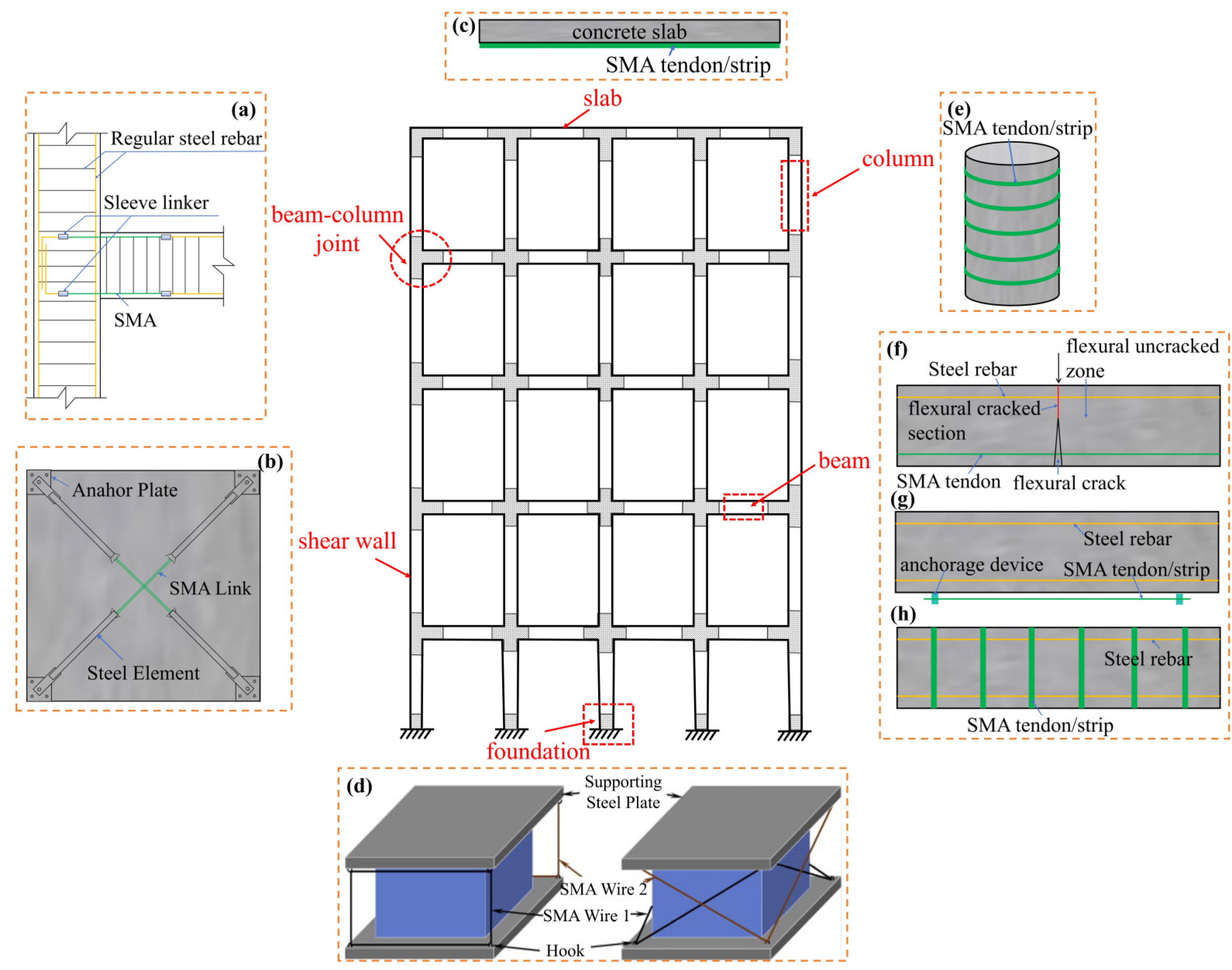
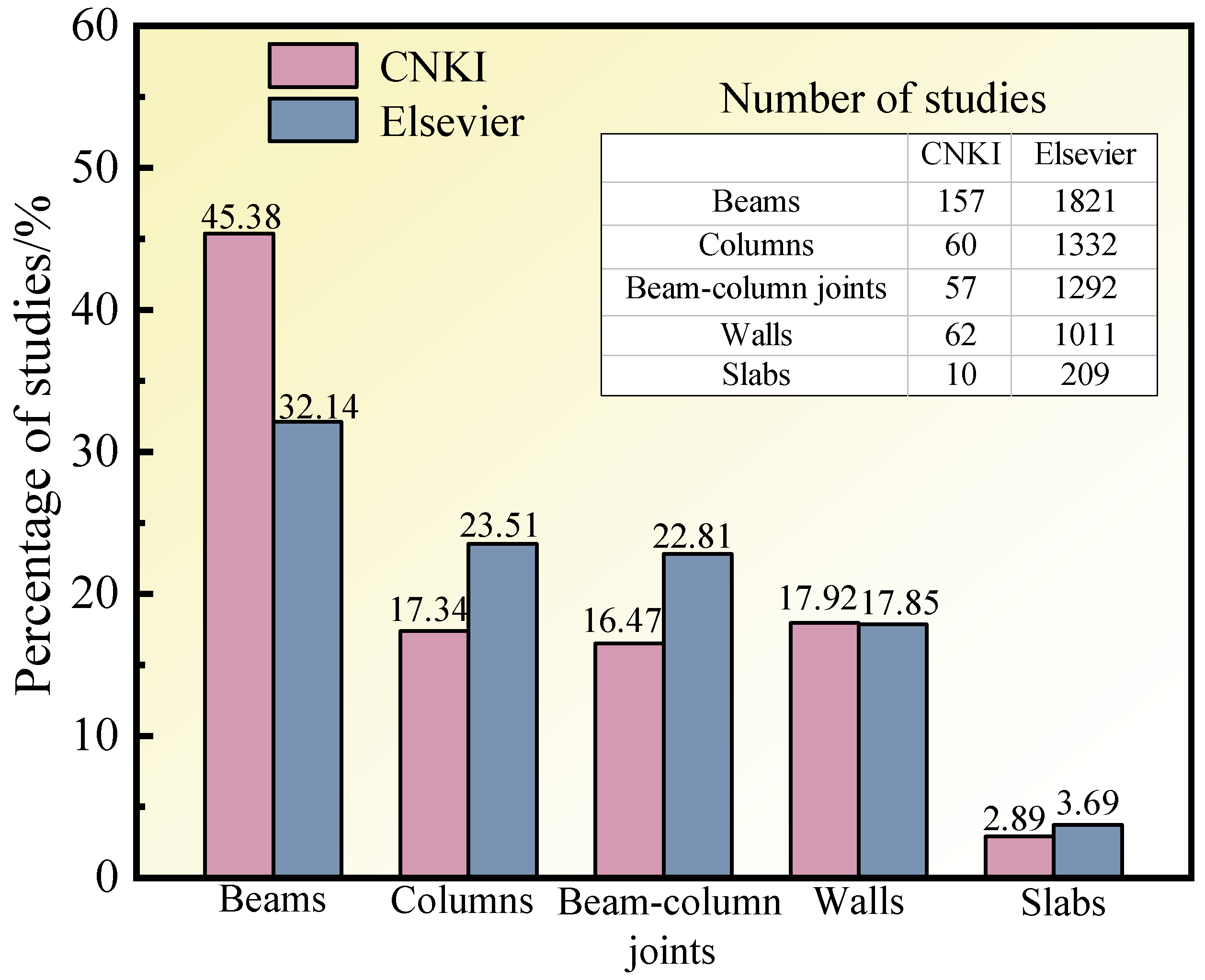

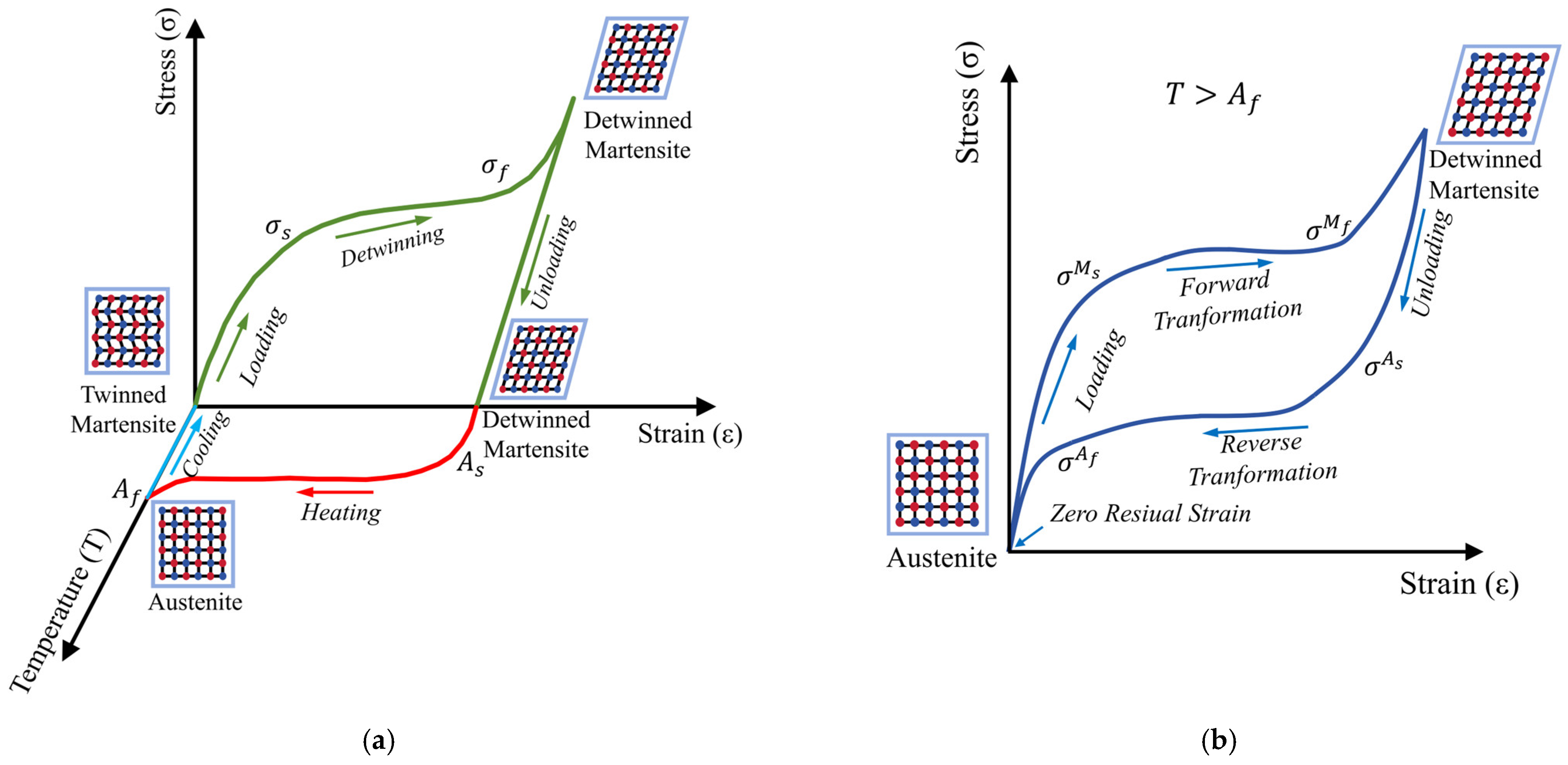
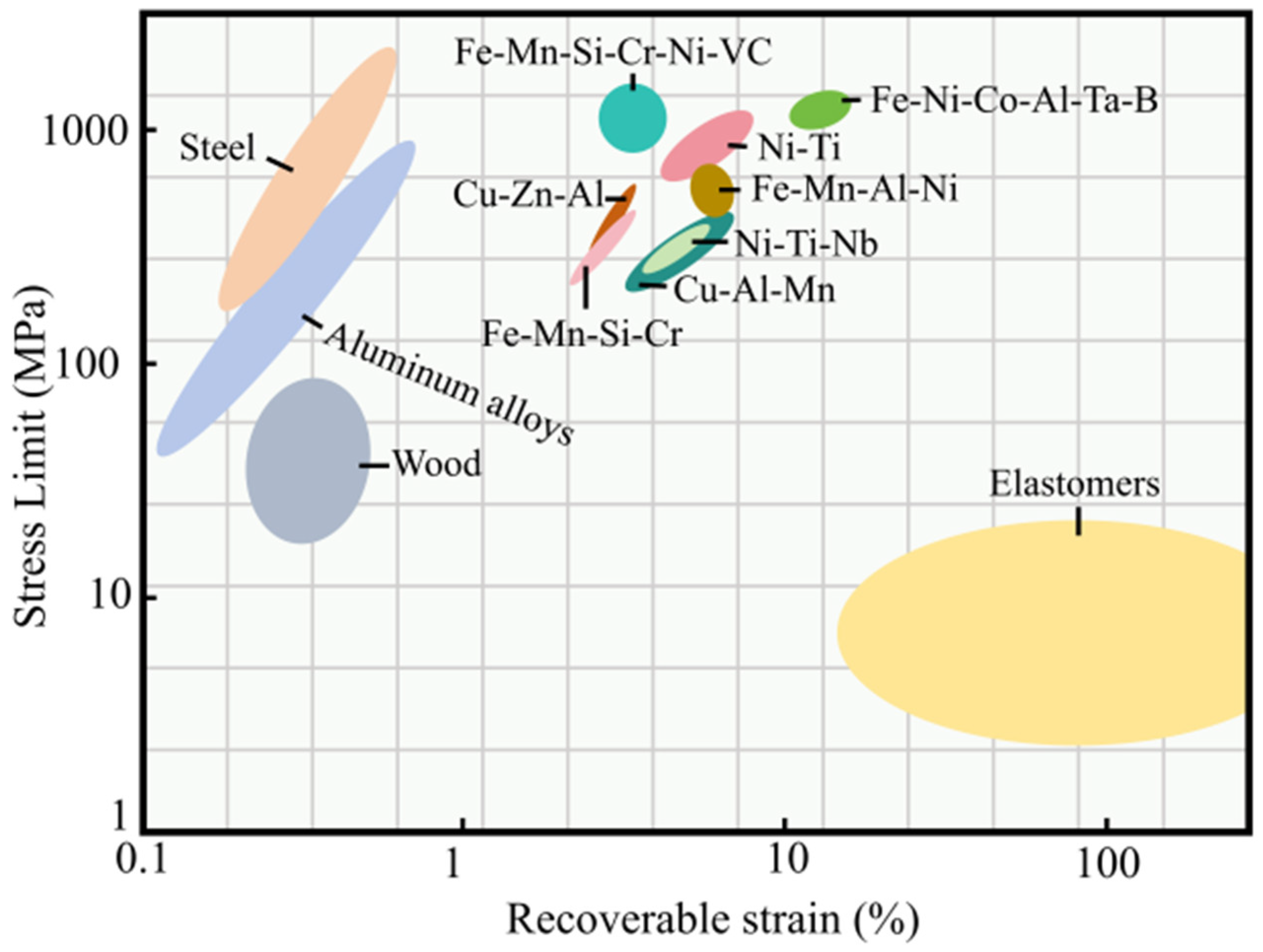
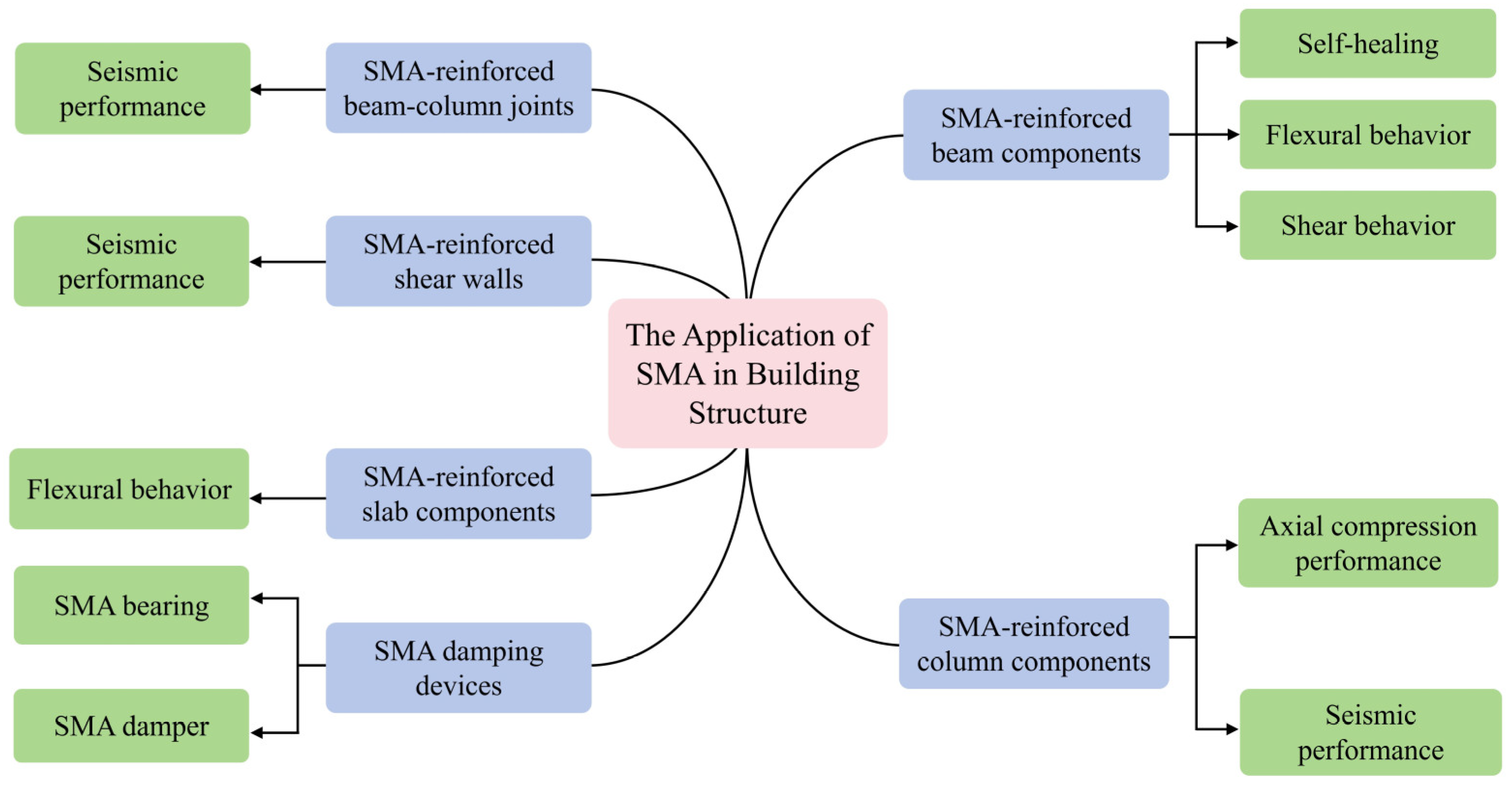
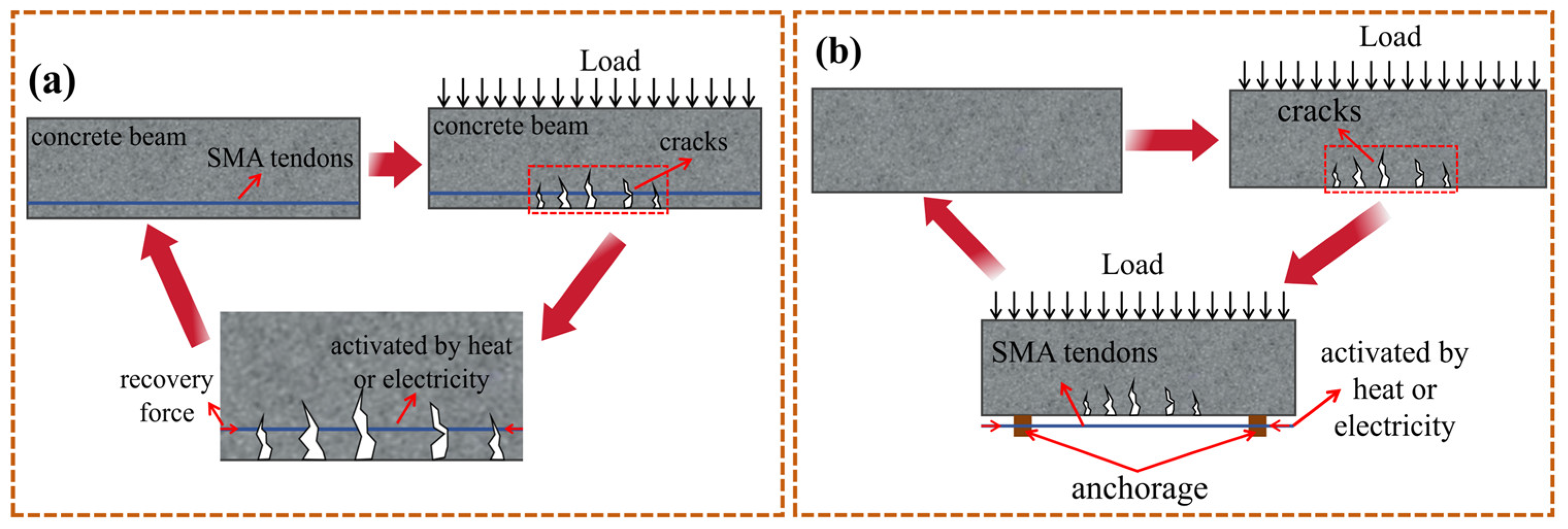
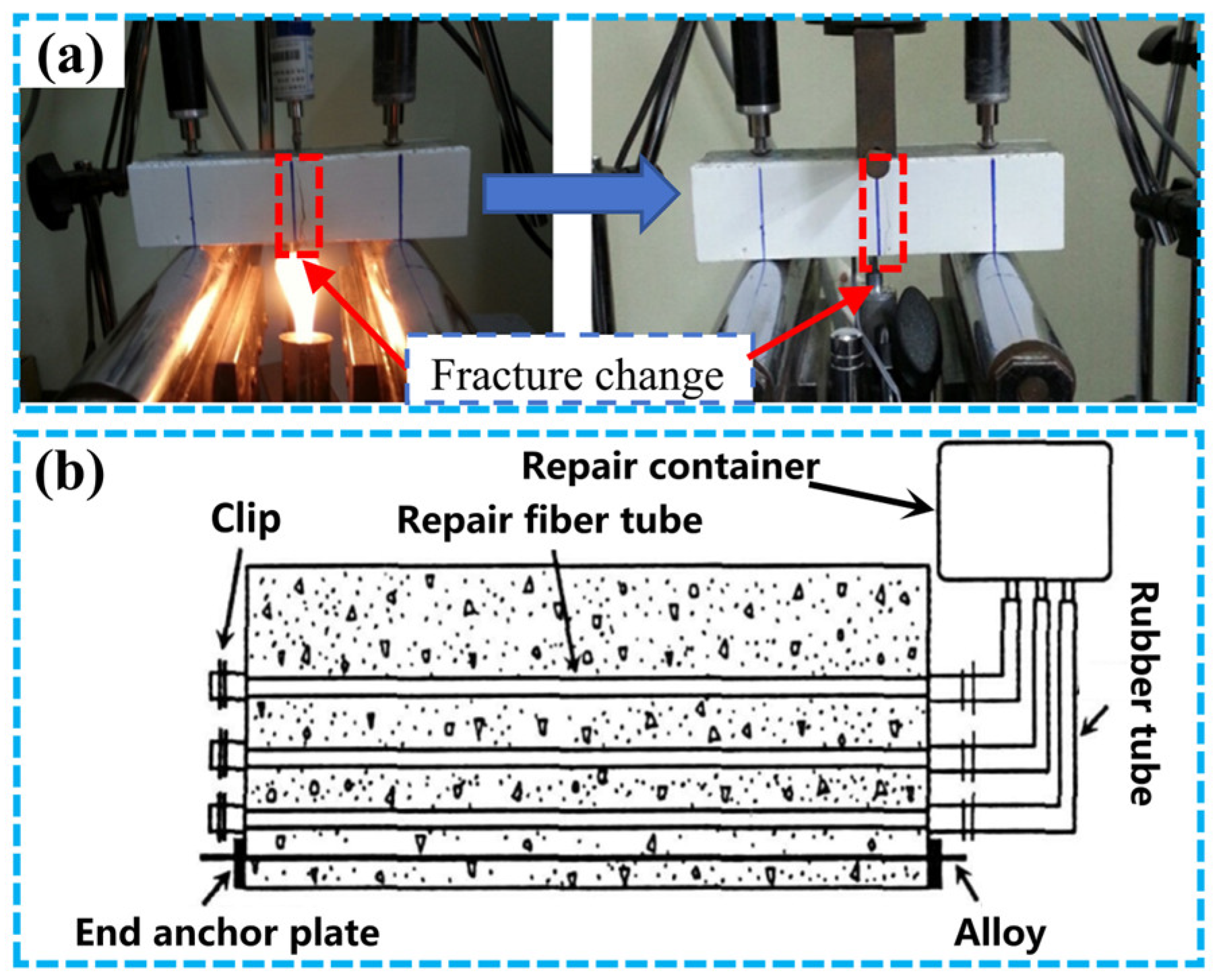



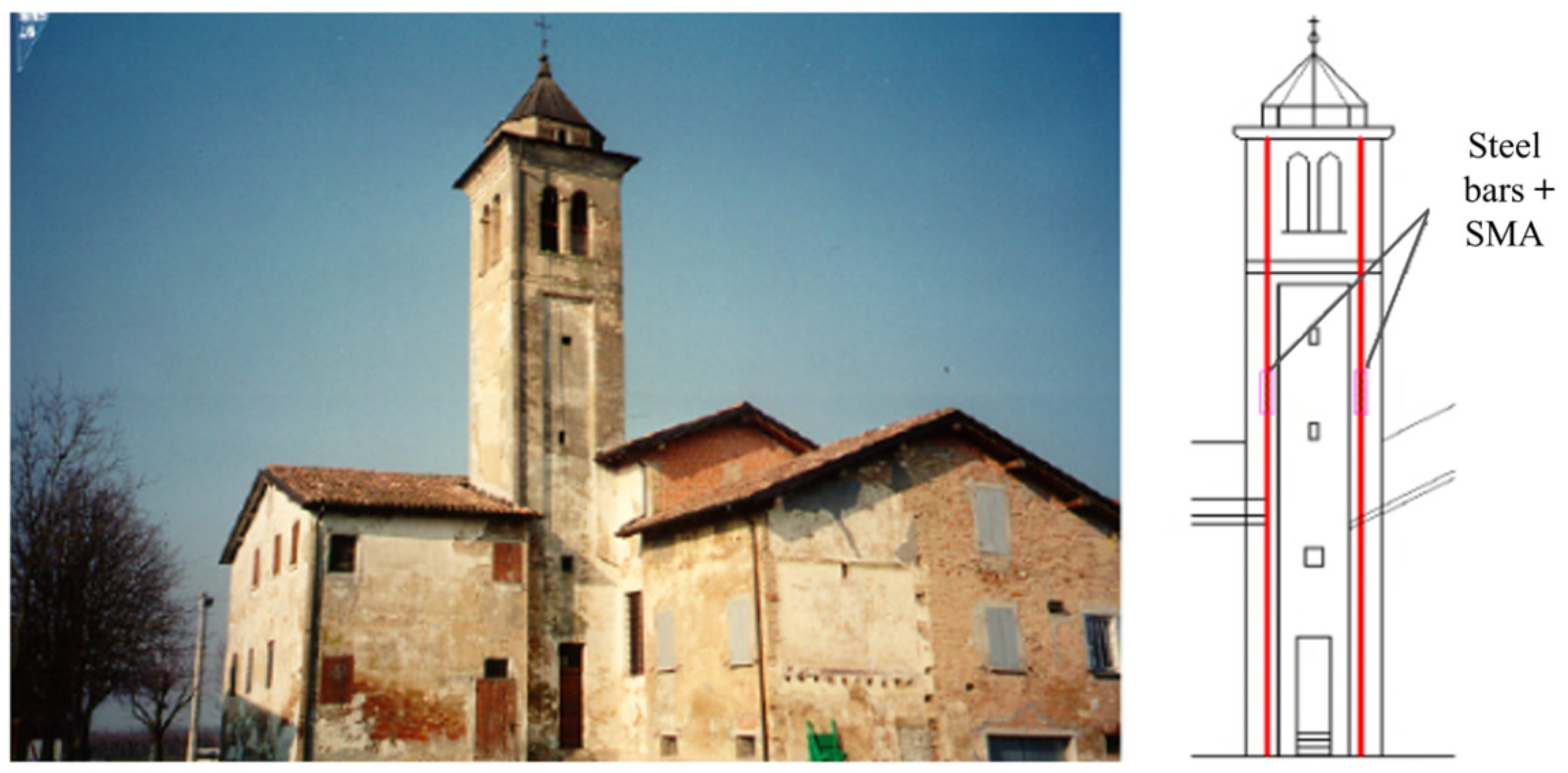

Disclaimer/Publisher’s Note: The statements, opinions and data contained in all publications are solely those of the individual author(s) and contributor(s) and not of MDPI and/or the editor(s). MDPI and/or the editor(s) disclaim responsibility for any injury to people or property resulting from any ideas, methods, instructions or products referred to in the content. |
© 2024 by the authors. Licensee MDPI, Basel, Switzerland. This article is an open access article distributed under the terms and conditions of the Creative Commons Attribution (CC BY) license (https://creativecommons.org/licenses/by/4.0/).
Share and Cite
Xu, L.; Zhu, M.; Zhao, J.; Chen, M.; Shi, M. The Utilization of Shape Memory Alloy as a Reinforcing Material in Building Structures: A Review. Materials 2024, 17, 2634. https://doi.org/10.3390/ma17112634
Xu L, Zhu M, Zhao J, Chen M, Shi M. The Utilization of Shape Memory Alloy as a Reinforcing Material in Building Structures: A Review. Materials. 2024; 17(11):2634. https://doi.org/10.3390/ma17112634
Chicago/Turabian StyleXu, Lidan, Miaomiao Zhu, Jitao Zhao, Ming Chen, and Mingfang Shi. 2024. "The Utilization of Shape Memory Alloy as a Reinforcing Material in Building Structures: A Review" Materials 17, no. 11: 2634. https://doi.org/10.3390/ma17112634










